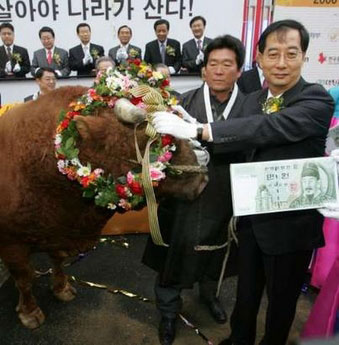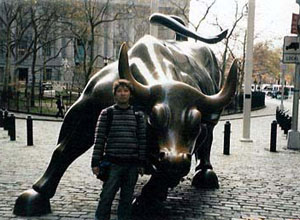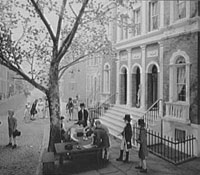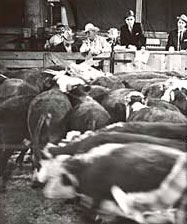Human Flower Project
Of Bull Markets
Finance leaders in Seoul crown a bull with flowers to begin stock-trading in the new year.

South Korea’s Finance and Economy Minister Han Duck-soo
decorated a bull with flowers January 2 at the Korea Exchange.
Photo: Kim Kyung-Hoon for Reuters
Over the past decade or so, South Korea’s economy has been lurching ahead only to lunge backward. It’s time for a steadying influence. Thus, a stolid bull was led into the Korea Exchange in Seoul yesterday. Finance minister Han Duck-soo ceremonially crowned the animal with a wreath of flowers, opening a new year of trading.
Is this a first for such a fine floral gesture? Likely not. The bull has special fascination and significance in Korea, admired as “powerful,” “noble,’’ and “tractable.’’ (It’s that tractable element that the nation’s economy may need most.)
 Outside the NYSE
Outside the NYSE
Photo: Fumi’s Web Page
Of course, in the U.S. and elsewhere, “bulls” are those with strong optimism about the market, and the capital to lay behind it. The wonderful rip-snorting sculpture outside the New York Stock Exchange is one of Lower Manhattan’s most popular works of public art. Frankfurt, Germany, we learn, also has a bull outside its stock exchange (matched with a more fiscally conservative bear).
Here is an excellent primer in the development of stock exchanges, written for interested non-economists. From it we learned, among many other things, that the first such trading was instituted to pay off a war debt (!!!???).
 The Buttonwood Agreement
The Buttonwood Agreement
As for the New York exchange, it began as The Buttonwood Agreement, when 24 merchants, bankers and general good-ol-boys gathered “at 68 Wall Street, under a buttonwood tree,” and agreed to trade securities. (Here’s a glossary, if you need to brush up on your brokerage terminology, as we do).
But what about blooms and bulls? The practice of decorating cows with flowers is a rite of spring in many parts of the world, an expression of the season’s richness. (Capitalists, of course, call seasons “quarters” and expect riches not just in spring but summer, fall and winter as well.) Ancient Egyptians paid homage to Apis and would march in procession behind an ornamented bull. The sacred cows of India often have their necks encircled with flowers (check the video here: a flower-bearing cow blesses a new building). And in case you missed them, here are some very dressy bulls, Beatriz Inglessis’s marvelous photographs from the Feast of San Isidro in Timotes, Venezuela last May. Of course, the bull has a special place in the hearts of Texans (“hook ‘em horns!”).
We also came across this admittedly arcane but amazing connection between Taurus the bull and the founding of the New York Stock Exchange. It’s all wound up with Masonic astrology and the Pleiades; Rose, Jim, Lee, Johns B and L, please get out your telescopes and advise.
But it IS 2006, after all. Do you find it a bit incongruous that a leader of Korea’s economy is decorating bulls? We do, and have decided that’s just the point.
No matter how you slice it or blow it dry, stock trading is gambling. It’s betting that whatever you can lay claim to now will be worth more later (or less, if you’re that kind of cowboy). Being essentially games of chance, stock exchanges around the world are full of peculiar customs, and many traders are noticeably superstitious.
According to one belief, the outcome of the Super Bowl—also big with gamblers—forecasts whether stocks will go up or down. In 1995, the stock market in Pakistan sank so far that brokers reportedly led 10 goats through the Karachi exchange and slaughtered them in the parking lot.
 A livestock market in Nebraska
A livestock market in Nebraska
Photo: Living History Farm
Wherever there’s risk and uncertainty, rituals will proliferate, from the ringing of the opening and closing bells on Wall Street to the much lovelier decorating of a bull in Seoul yesterday. It’s a matter of keeping one’s footing. More than the rest of us, those who make a living out of speculation and abstractions are out of touch. Who needs flowers and bulls more than someone who spends all day talking on two telephones at once, staring at numbers, waving his hands in the air, and bidding the promise of a stranger’s money on a sliver of another stranger’s potential for success? Makes you lust for daisies and a side of beef.
Long before there was Merrill-Lynch or AT&T, stock trading meant swapping ewes or selling your cattle to a “packer buyer”—the kind of activity that could involve something gritty, like pushing open a horse’s mouth to take a look at its teeth. No longer.
The floral observance at the Korea Exchange suggests market optimism, perhaps, and a definite touch of vertigo.

